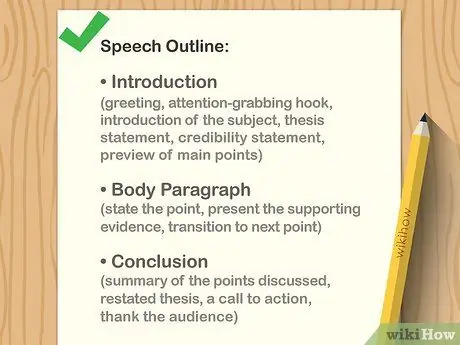- Author Jason Gerald [email protected].
- Public 2023-12-16 10:50.
- Last modified 2025-01-23 12:04.
Many people have glasophobia or are afraid of speaking in front of large crowds. If you experience this, the anxiety and fear of speaking in front of an audience can be overcome by being well prepared and applying some calming techniques. Also, apply the following tips to feel confident when speaking in front of an audience, regardless of the purpose and subject matter.
Step
Method 1 of 3: Preparing Speech Materials

Step 1. Decide why you want or need to speak in front of an audience
Maybe you got an assignment to give a speech or give a presentation at school or at work. You may also be invited as a speaker to explain a subject according to your expertise or interest. When preparing your speech material, keep these reasons in mind so that you stay focused on what you want to convey to your audience or the goal you want to achieve.
If you have to do a school assignment to give a speech in front of the class, make sure you prepare the material according to the rules by reading the bibliography and detailed paper drafting guides

Step 2. Find information about the audience so that the speech material can be tailored to their interests
Prepare useful and interesting material to keep the audience listening. Find out each participant's age, background and education. Consider their beliefs, values, and possible responses to the topics discussed. This step helps you adapt your material to those things so that your speech is more effective.
- Before you start your speech, take the time to talk to a few participants to get an idea of what they need and why they want to hear you speak.
- For example, when giving a speech to a group of high school students, use easy-to-understand and humorous words. However, you should speak in a formal style when speaking to the military.

Step 3. Focus on the goal you want to achieve when compiling the speech material
Depending on the audience that will be attending, you will usually need to gather information on the topic before drafting the material. Then, create a material outline containing all the main ideas you want to convey. Gather supporting facts, statistics, and insert anecdotes or humorous stories worth telling. Write all the material on a note card as a tool when practicing.
- Focus on the reasons that make you want to give a speech and make sure the entire material supports the achievement of a goal or motivates the audience to take concrete action.
- One of the determinants of the success of a speech is an opening that is very interesting or provokes curiosity. Tell a story, statistical data, or fact that grabs attention so that the audience is interested in learning more about it.
- Present your main idea using a syllogism so the audience can understand your argument. Use transitions to direct your audience to the next idea.
- End the speech by provoking the audience with an anecdote, fact, or solution so that they stay inspired by what you have to say even after the speech is over.

Step 4. Do the speech according to the specified time span
If time is limited, make sure you give your speech according to a schedule. Practice with different speech tempos while noting the duration and then determine the material that needs to be reduced. Usually, the more concise the material, the better!
In general, a 5-minute speech contains 750 words and a 20-minute speech contains 2,500-3,000 words

Step 5. Practice until you don't have to look at the notes
Good preparation plays an important role when speaking in front of an audience. While you can read notes, try to memorize the material or at least the important things you want to convey so that you don't rely on notes during your speech.
- Training does not need to be started from scratch. Start with different sections of the material so you can memorize the entire material even if it's not in order. That way, you're ready to continue your speech if things get distracting or confusing.
- Practice in front of the mirror, in the car, while gardening, exercising, cleaning the house, shopping, or anytime so that you have more time to practice and memorize the material as best you can.

Step 6. Use visual aids if needed
Visual aids can help you reduce your nervousness because there are tools you can use to focus your attention. Prepare slides, props, posters, or other visual means that are useful for conveying the main idea according to the topic and objectives to be achieved.
Make a contingency plan in case the electronic equipment malfunctions! Be prepared to give a speech without a projector just in case
Method 2 of 3: Calming Yourself

Step 1. Come to the speech venue a few days in advance
If you've never been to a speech venue, finding out what the room is like can help reduce anxiety. Set aside time to come to the event location and find out where the restrooms, exits, and so on are located.
Take this opportunity to determine the route of travel so that you can calculate the travel time to the event location

Step 2. Pay attention to your appearance
Good appearance makes you feel calm. Therefore, take the time to make up before giving your speech. Wear clothes that make you look good, but choose something that suits the activity. Do your hair or get a manicure to make you feel more confident.
In general, size-fitting trousers and a button-down shirt are suitable for making a speech. In addition, you can wear a suit and tie (for men) or short skirts, blouses and blazers (for women). Make sure you are wearing clean and not tattered clothes

Step 3. Admit that you are afraid so you can overcome it
The fear of speaking in front of an audience is nothing to be ashamed of. Admit that you are scared and don't beat yourself up. Say to yourself, "My heart is beating very fast, my mind is empty, my stomach is churning". Then remind yourself that this is normal and that the adrenaline that triggers these symptoms is a sign that you want to do your best.
- Turn fear into enthusiasm so you can prove to your audience how important the information you want to convey is.
- Imagining your successful speech helps you do well. Therefore, take the time to visualize for a few minutes by imagining the speech going smoothly.

Step 4. Relieve anxiety before heading to the podium
Sometimes, adrenaline makes you more excited and energetic. Before giving your speech, do a few star jumps, wave your hands, or dance to your favorite song. This will make you feel calmer and able to focus your mind while standing in front of an audience.
You can exercise in the morning to reduce nervousness and excess energy

Step 5. Breathe deeply and calmly to calm yourself down
You may have heard this message many times, but this breathing technique is very effective. Inhale for 4 counts, hold breath for 4 counts, exhale for 4 counts. Repeat until your heart rate returns to normal and you feel calm.
Do not take short breaths because this can trigger hyperventilation
Method 3 of 3: Speech

Step 1. Stand facing the audience
Maybe you prefer to have your back to the audience staring at you. However, you will feel more confident if you stand in front of your audience and interact directly with them. Stand with your body straight and pull your shoulders back. You can do it!

Step 2. Imagine that you are talking to a friend
Thinking about different things about your audience and their reactions may make you even more nervous. To calm yourself down and feel more confident, imagine you're talking to a friend or coworker.
One tip that is often recommended is to imagine you are talking in an empty room, but this may make you feel uncomfortable. If these tips are able to overcome anxiety or fear, just do it

Step 3. Speak at a normal tempo
Many people speak more quickly when they are nervous or want to finish their speech immediately. However, this method makes it difficult for the audience to understand what you are saying. On the other hand, don't speak so slowly that the audience gets bored or feels unappreciated. Speak at a tempo like you are having a conversation with someone.
If you want to speak with an effective technique, say 190 words/minute during your speech

Step 4. Speak loudly and clearly so everyone can hear what you are saying
When speaking in public, make sure everyone understands what you are saying. Say each word out loud, with clear articulation, and a firm tone. Use a microphone if you have one. If not, speak louder than usual, but don't scream.
Before your speech, warm up to flexing your tongue by repeating "sasisuseso mamimumemo naninuneno" or "snake coiled around the fence."

Step 5. Make eye contact with people you know in the audience
If a friend or family member is present as one of the attendees, make eye contact with them. A nod of the head or an encouraging smile can make you feel calm and confident. If you don't know anyone, pick a few people in your audience and make occasional eye contact to make participants feel connected to you when you talk to them.
If you dare not make eye contact, look straight ahead slightly above the audience's head. Do not look up or at the floor

Step 6. Speak in an expressive style
Don't speak in a monotone while standing like a statue. When chatting, people usually take a few steps, move their hands, and express their feelings through facial expressions. Do the same when speaking in front of an audience! Use body language and inflections to show enthusiasm and the importance of the topic being discussed.
Express your emotions to make your audience feel connected to you, but don't overdo it or get so carried away that you have trouble controlling yourself. Look for a balance between being professional and emotional

Step 7. Pause if necessary
Silence is not a bad thing, especially if it has its benefits. Don't think that you have to keep talking. Take a moment to focus your thoughts if you feel nervous or confused. Also, you can take a moment to pause so the audience can understand what you're saying, especially if you're explaining something important or provocative.

Step 8. Continue the speech if you make a mistake
Saying the wrong words or forgetting important information can be very scary. Remember that everyone is not free from mistakes. Mistakes might be a big deal to you, but the audience might not care. Instead of feeling helpless or leaving the podium, take a deep breath and then continue your speech. Don't focus on the mistakes, but try to make the audience understand your message.
Don't demand yourself to be perfect because nobody is perfect! Accept yourself as you are
Tips
- Improve your speaking skills in front of an audience by joining a group, such as Toastmasters.
- Attend seminars to find out how to give a good speech and what to avoid.
- Don't pretend to be someone else when speaking in front of an audience. Show who you really are and how important your opinion is.
Warning
- As much as possible, avoid reading notecards or slides during your speech.
- Do not blame yourself. Even if your speech doesn't go well, there's still time to improve it.






